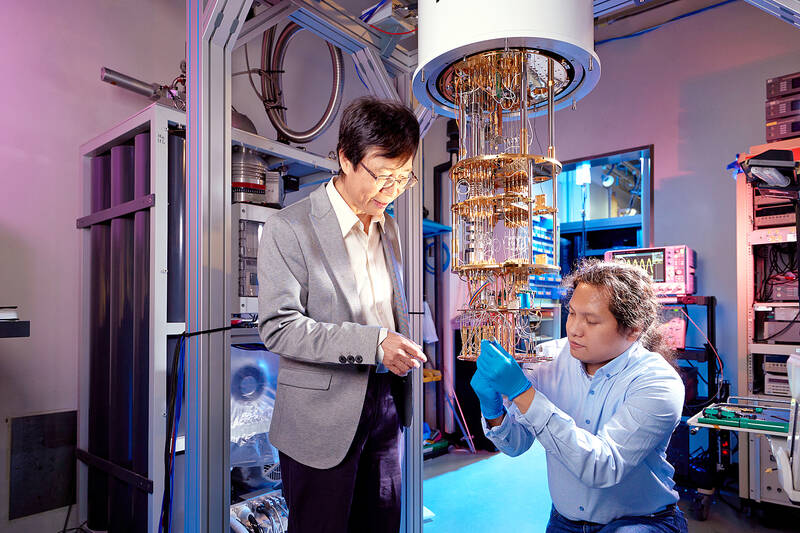Academia Sinica yesterday unveiled a quantum computer based on 5-quantum-bit (qubit) chips, connecting the device to the Internet to enable its use in scientific research by the institution’s members and partners.
The computer’s launch marked another milestone in the nation’s research into and development of quantum computing following the chip’s creation in October last year, said Chen Chii-dong (陳啟東), a research fellow at Academia Sinica’s Research Center of Applied Sciences.
Researchers participating in the Ministry of Science and Technology’s project accomplished the objectives ahead of the ministry’s schedule, which had stipulated the development of 3-qubit chips by February last year, he said.

Photo courtesy of Academia Sinica
The Taiwanese quantum computer’s logic gate reached a 99.9 percent fidelity rate, he added.
Although great strides have been and are being made in quantum computing technology, there is still a long way to go for its practical application in the commercial sector or for personal use, Academia Sinica said.
The 5-qubit computer is now available for use as a test and development platform for quantum computing, ultra-low temperature complementary metal oxide semiconductor (CMOS) and operational amplifier research programs, it said.
The Taiwanese research team has consistently outperformed expectations despite being given less time and resources than the quantum computer research programs of foreign nations, Academia Sinica President James Liao (廖俊智) said.
The program’s successful achievements are a basic part of the technology, and researchers need time to resolve foundational problems before breaking through the next bottleneck, he said.
Academia Sinica’s work in quantum computing is intended to blaze a trail for the nation’s private sector and generate the momentum necessary to sustain the investment in talent and education, Liao said.
Taiwan’s quantum computing project is a collaboration between Academia Sinica, the Industrial Technology Research Institute, National Changhua Normal University, National Central University, National Chung Hsin University, the University of California, Santa Barbara and the University of Wisconsin-Madison, it said.

‘WIN-WIN’: The Philippines, and central and eastern European countries are important potential drone cooperation partners, Minister of Foreign Affairs Lin Chia-lung said Minister of Foreign Affairs Lin Chia-lung (林佳龍) in an interview published yesterday confirmed that there are joint ventures between Taiwan and Poland in the drone industry. Lin made the remark in an exclusive interview with the Chinese-language Liberty Times (the Taipei Times’ sister paper). The government-backed Taiwan Excellence Drone International Business Opportunities Alliance and the Polish Chamber of Unmanned Systems on Wednesday last week signed a memorandum of understanding in Poland to develop a “non-China” supply chain for drones and work together on key technologies. Asked if Taiwan prioritized Poland among central and eastern European countries in drone collaboration, Lin

The Chien Feng IV (勁蜂, Mighty Hornet) loitering munition is on track to enter flight tests next month in connection with potential adoption by Taiwanese and US armed forces, a government source said yesterday. The kamikaze drone, which boasts a range of 1,000km, debuted at the Taipei Aerospace and Defense Technology Exhibition in September, the official said on condition of anonymity. The Chungshan Institute of Science and Technology and US-based Kratos Defense jointly developed the platform by leveraging the engine and airframe of the latter’s MQM-178 Firejet target drone, they said. The uncrewed aerial vehicle is designed to utilize an artificial intelligence computer

Renewed border fighting between Thailand and Cambodia showed no signs of abating yesterday, leaving hundreds of thousands of displaced people in both countries living in strained conditions as more flooded into temporary shelters. Reporters on the Thai side of the border heard sounds of outgoing, indirect fire yesterday. About 400,000 people have been evacuated from affected areas in Thailand and about 700 schools closed while fighting was ongoing in four border provinces, said Thai Rear Admiral Surasant Kongsiri, a spokesman for the military. Cambodia evacuated more than 127,000 villagers and closed hundreds of schools, the Thai Ministry of Defense said. Thailand’s military announced that

CABINET APPROVAL: People seeking assisted reproduction must be assessed to determine whether they would be adequate parents, the planned changes say Proposed amendments to the Assisted Reproduction Act (人工生殖法) advanced yesterday by the Executive Yuan would grant married lesbian couples and single women access to legal assisted reproductive services. The proposed revisions are “based on the fundamental principle of respecting women’s reproductive autonomy,” Cabinet spokesperson Michelle Lee (李慧芝) quoted Vice Premier Cheng Li-chiun (鄭麗君), who presided over a Cabinet meeting earlier yesterday, as saying at the briefing. The draft amendment would be submitted to the legislature for review. The Ministry of Health and Welfare, which proposed the amendments, said that experts on children’s rights, gender equality, law and medicine attended cross-disciplinary meetings, adding that